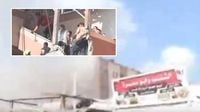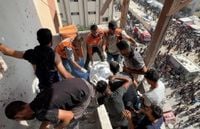On August 25, 2025, the Nasser Hospital in Khan Younis, southern Gaza, became the epicenter of a tragedy that has drawn international outrage and renewed scrutiny on the perilous conditions faced by journalists in conflict zones. In a pair of strikes—described by witnesses and officials as a “double-tap” attack—at least 22 people were killed, including five journalists, medical workers, and emergency responders. The strikes, which targeted the fourth floor and a balcony often used by reporters for its elevated vantage point, have been widely condemned by journalist organizations, humanitarian groups, and governments worldwide.
The journalists killed in the attack were identified as Mohammad Salama, a cameraman for Al Jazeera; Hussam al-Masri, a contractor for Reuters; Mariam Abu Daqqa, who worked for The Independent Arabic and The Associated Press; Moaz Abu Taha; and Ahmed Abu Aziz, who succumbed to his wounds later, according to Gaza’s Government Media Office. The Ministry of Health in Gaza confirmed that the journalists were among the victims of the strike, which also claimed the lives of health workers and members of emergency response crews who had rushed to the scene after the initial explosion. Video footage from the aftermath showed chaos as a second blast rocked the hospital, sending debris flying and forcing rescuers and journalists to flee for cover.
According to Reuters and CNN, the attack unfolded in rapid succession: the first missile hit the hospital’s fourth floor, followed moments later by a second strike as rescue teams and media professionals converged on the site. Dr. Mohammad Saqer, the hospital’s head of nursing, confirmed the deaths and described the attack as a deliberate targeting of those trying to document and respond to the devastation. Gaza’s Civil Defense organization reported that one of its crew members also died in the strike.
Prime Minister Benjamin Netanyahu acknowledged the deaths, calling them a “tragic mishap.” In a statement released by his office, Netanyahu said, “Israel values the work of journalists, medical staff, and all civilians. The military authorities are conducting a thorough investigation.” The Israel Defense Forces (IDF) echoed this sentiment, with spokesman Brig. Gen. Effie Defrin stating, “The IDF does not intentionally target civilians. Any incident that raises concern in this regard is addressed by the relevant mechanisms in the IDF.” Defrin cited the “extremely complex reality” in Gaza, blaming Hamas for embedding itself in civilian infrastructure and asserting that the military was targeting what it alleged to be a camera used by Hamas to monitor Israeli forces. However, journalist organizations and international observers have questioned these justifications, noting the lack of independently verifiable evidence.
The Committee to Protect Journalists (CPJ) has called the situation in Gaza the “deadliest and most deliberate effort to kill and silence journalists” it has ever recorded. Before Monday’s attack, the CPJ had documented 192 journalists killed in Gaza since the war began in October 2023—almost all of them Palestinian. Jodie Ginsberg, CPJ president, accused Israel of deliberately targeting a Reuters camera position, stating, “First responders moved in, including journalists, and they were killed in the second attack. So in both instances, it looks like Israel has committed unlawful killings, war crimes, both in the deliberate killing of the Reuters cameraman and in this so-called double tap attack.”
The Foreign Press Association in Israel and the Palestinian Territories described the strikes as “among the deadliest Israeli attacks on journalists working for international media since the Gaza war began.” The organization called the attack a “watershed moment,” adding, “This has gone on far too long. Too many journalists in Gaza have been killed by Israel without justification. Israel continues to block international journalists from independent access to Gaza.”
International humanitarian law is explicit: journalists are civilians and must not be targeted during combat. Yet, as The Conversation notes, the deaths at Nasser Hospital are part of a long and troubling pattern. Since Israel’s military occupation of Palestinian territories began in 1967, Palestinian journalism has operated under severe constraints. Military Order 101, issued shortly after the Six-Day War, criminalized political assembly and “propagandistic” publications. Over the decades, Israeli authorities have enforced military censorship, detained or deported editors, and revoked press cards for journalists deemed too critical or allegedly linked to Palestinian political groups.
Even the Oslo Accords of the 1990s, which many hoped would usher in greater press freedoms, did little to change the status quo. Both Israeli and Palestinian authorities have imposed their own forms of censorship, with the Palestinian Authority also arresting and suspending critical news outlets. The situation has only worsened during periods of heightened conflict. In 2002, Israeli forces fatally shot Palestinian photographer Imad Abu Zahra; in 2003, British filmmaker James Miller was killed in Rafah; and in 2008, Reuters cameraman Fadel Shana died in Gaza. During the 2018 Great March of Return protests, Israeli forces killed journalists Yaser Murtaja and Ahmed Abu Hussein—both wearing clearly marked “PRESS” vests—and wounded at least 115 others.
Perhaps the most high-profile case was the killing of Palestinian American journalist Shireen Abu Akleh in May 2022 in the Jenin refugee camp. Israeli officials initially blamed Palestinian militants, but later admitted there was a “high possibility” that Israeli forces had killed her, insisting it was accidental and declining to press charges. A recent documentary has challenged this account, alleging that the killing was intentional.
Hospitals, too, have become frequent targets. The Nasser Medical Complex, the main hospital in southern Gaza, has withstood multiple raids and bombardments throughout the 22-month war, facing critical shortages of supplies and staff. In June 2025, another attack on the hospital killed three people and wounded 10; Israel claimed it was targeting Hamas fighters operating from within, but provided no evidence.
The August 25 strike is not an isolated incident. Two weeks prior, Israeli forces killed Al Jazeera correspondent Anas al-Sharif and five fellow journalists in Gaza City. Israel accused Al-Sharif of being a Hamas commander, a charge he had denied. The persistent refusal to allow international news agencies access to Gaza means that local Palestinian journalists are often the only ones bearing witness to the conflict—at great personal risk. As the CPJ, AP, and Al Jazeera have all emphasized, this has created an environment where journalists are not only documenting war but also becoming its casualties.
The international response has been swift and forceful. United Nations Secretary-General Antonio Guterres condemned the killings, calling for civilians—including journalists and medical workers—to be “protected at all times” and able to carry out their work “without interference, intimidation, or harm.” The UN’s main agency for Palestinian refugees, UNRWA, called the strikes an attempt to “silence the last remaining voices reporting about children dying silently amid famine.” Countries including Canada, the UK, Germany, Switzerland, Qatar, Saudi Arabia, and Kuwait have all issued statements of condemnation and called for impartial investigations.
For the families and colleagues of the victims, the loss is deeply personal. Mariam Abu Daqqa, one of the journalists killed, had told CNN in 2024, “We are covering the war on Gaza because this is our journalistic duty. It is entrusted upon us.” Her 12-year-old son was evacuated from Gaza earlier in the war. The Associated Press said it was “shocked and saddened” by her death, noting her reporting on the struggles of doctors trying to save children amid starvation.
As the war in Gaza continues, the deaths at Nasser Hospital serve as a grim reminder of the dangers faced by those who document conflict—and the urgent need for accountability and protection of journalists. Whether the latest tragedy will prompt meaningful change remains uncertain, but the world is watching, and the calls for justice grow louder with each loss.


